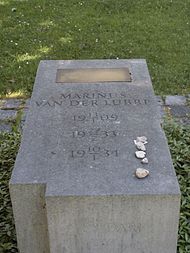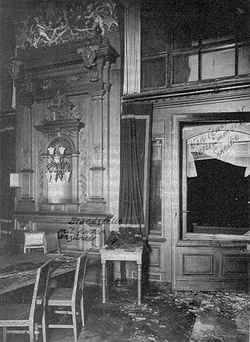- Marinus van der Lubbe
-
Marinus (Rinus) van der Lubbe (13 January 1909 – 10 January 1934) was a Dutch council communist convicted of, and controversially executed for, setting fire to the German Reichstag building on February 27, 1933, an event known as the Reichstag fire. .[1]
Contents
Biography
Marinus van der Lubbe was born in Leiden in the province of Zuid-Holland. He was born with learning difficulties, and apparently had a fascination with fire. His parents were divorced and, after his mother died when he was 12, he went to live with his half-sister's family. In his youth Van der Lubbe worked as a bricklayer. He was nicknamed Dempsey after the boxer Jack Dempsey, because of his great strength. At his work, van der Lubbe came in contact with the labor movement; in 1925, he joined the Dutch Communist Party (CPH), and its youth section the Communist Youth Bund (CJB).
In 1926, he was injured at work, getting lime in his eyes, which left him in the hospital for a few months and almost blinded him. The injury forced him to quit his work, so he was unemployed with a pension of only 7.44 guilders a week. Not being able to live off this, he was forced to take occasional jobs. After a few conflicts with his sister, van der Lubbe moved to Leiden in 1927. There he learned to speak some German and founded the Lenin house, where he organized political meetings. While working for the Tielmann factory a strike broke out. Van der Lubbe claimed to the management to be one of the ringleaders and offered to accept any punishment as long as no one else was victimised, even though he was clearly too inexperienced to have been seriously involved. During the trial, he tried to claim sole responsibility and was purportedly hostile to the idea of getting off free.
Afterwards, van der Lubbe planned to emigrate to the Soviet Union, but he lacked the funds to do so. He was politically active among the unemployed workers' movement until 1931, when he fell into disagreement with the CPH and instead approached the Internationalist Communist Group (IKG). In 1933, van der Lubbe fled to Germany to take action in the local communist underground. He had a criminal record for arson.
Reichstag fire
According to the Berlin police, van der Lubbe claimed to have set the Reichstag building on fire as a cry to rally the German workers against fascist rule. Under torture, he confessed again and was brought to trial along with the leaders of the opposition Communist Party. At his trial van der Lubbe was convicted and sentenced to death for the Reichstag fire. The other four defendants (Ernst Torgler, Georgi Dimitrov, Blagoi Popov, and Vassili Tanev) at the trial were acquitted. He was guillotined in a Leipzig prison yard on 10 January 1934, three days before his 25th birthday. He was buried in an unmarked grave on the Südfriedhof (South Cemetery) in Leipzig.
After World War II, moves by Marinus van der Lubbe's brother, Jan van der Lubbe were made in an attempt to overturn the verdict against his brother. In 1967 his sentence was changed by a judge from death to eight years in prison. In 1980, after more lengthy complaints, a West German court overturned the verdict entirely, but this was protested by the state prosecutor. The case was re-examined by the Federal Court of Justice of Germany for three years, until in 1983 the court made a final decision over the matter, overturning the result of the earlier 1980 trial on grounds that there was no basis for it, making it therefore illegal. However, in January 2008, the Federal Court of Justice of Germany finally overturned the death penalty verdict based on a 1998 German law that makes it possible to overturn certain cases of Nazi injustice.[2] The determination of the court was based on the premise that the National Socialist regime was by definition unjust, and since the death sentence in this case was politically motivated, it was likely to have contained an extension of that injustice; the finding was independent of the factual question of whether or not it was van der Lubbe who actually set the fire.[2]
Cause of the Reichstag fire
Historians disagree as to whether Van der Lubbe was the sole culprit of the fire, despite Nuremberg testimony and other circumstantial evidence suggesting that he did not act alone. Some historians (especially Bahar and Kugel) believe that he was an unwitting pawn of the Gestapo, who manipulated him to create the event, though controversy about this exists too. Much difficulty is created by the fact that substantial amounts of evidence for all theories was later found to be manufactured by the Soviet Union or secret police after the event.
The forensic evidence from the scene, a set of photographs taken by the Berlin police department, shows many small fires started by van der Lubbe after he entered the building, apparently using fire-lighters. All of the examples of fires he set, such as one near the window on the ground floor where it is alleged he entered, self-extinguished. The main fire which was set in the debating chamber did succeed and destroyed the central parts of the building.
Notes
- ^ Marinus van der Lubbe was officially pardoned by the German state in January 2008, 75 years after his conviction and beheading. In 1967 a Berlin court had symbolically changed the sentence of van der Lubbe to eight years in prison and in 1980 the same court had lifted the sentence entirely. In 1981 a West German court overturned the conviction of van der Lubbe on the grounds that he was insane, however campaigners pressed for full state pardon on account of van der Lubbe having been convicted by a Nazi court. The full state pardon of van der Lubbe was made possible by a law passed in Germany in 1998. This exoneration is symbolic and will not lead to compensation for van der Lubbe's heirs.
Source: Kate Connolly, 75 years on, executed Reichstag arsonist finally wins pardon, The Guardian, Saturday 12 January 2008. [1] - ^ a b "Marinus van der Lubbe gerehabiliteerd (Dutch)". http://www.telegraaf.nl/binnenland/2992493/_Marinus_van_der_Lubbe_gerehabiliteerd__.html?p=15,1. Retrieved 2008-01-10.
References
- Bahar, Alexander and Kugel, Wilfried, Der Reichstagbrand, edition q (2001) German language only.
- Hersch Fischler: Zum Zeitablauf der Reichstagsbrandstiftung. Korrekturen der Untersuchung Alfred Berndts, in: Vierteljahrshefte für Zeitgeschichte 55 (2005), S. 617–632.(with English summary)
External links
- English translation of The Reichstag Fire (1963) by Fritz Tobias, with introduction by A. J. P. Taylor
- Biography Marinus van der Lubbe on libcom.org history
- Dutch Council Communism and Van der Lubbe Burning the Reichstag - The question of "exemplary acts" - the political repercussions of his act on his comrades
- [2] Article in Guardian, January 12, 2008
- Zuidenwind Filmproductions at www.zuidenwind.nl Documentary about Marinus van der Lubbe
- Marinus van der Lubbe rehabilitated (English)
Categories:- 1909 births
- 1934 deaths
- People from Leiden
- Dutch communists
- Left communists
- People condemned by Nazi courts
- People executed by decapitation
- People killed by Nazi Germany
- Bricklayers
- Dutch people executed abroad
- ^ Marinus van der Lubbe was officially pardoned by the German state in January 2008, 75 years after his conviction and beheading. In 1967 a Berlin court had symbolically changed the sentence of van der Lubbe to eight years in prison and in 1980 the same court had lifted the sentence entirely. In 1981 a West German court overturned the conviction of van der Lubbe on the grounds that he was insane, however campaigners pressed for full state pardon on account of van der Lubbe having been convicted by a Nazi court. The full state pardon of van der Lubbe was made possible by a law passed in Germany in 1998. This exoneration is symbolic and will not lead to compensation for van der Lubbe's heirs.
Wikimedia Foundation. 2010.



